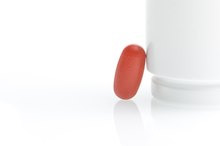What does fact checked mean?
At Healthfully, we strive to deliver objective content that is accurate and up-to-date. Our team periodically reviews articles in order to ensure content quality. The sources cited below consist of evidence from peer-reviewed journals, prominent medical organizations, academic associations, and government data.
- Centers for Disease Control & Prevention: Recommendations to Prevent and Control Iron Deficiency in the United States
- “Journal of the American Board of Family Medicine”; Cefdinir-Associated “Bloody Stools” in an Infant; R. Graves, SP. Weaver; May 2008
- “Journal of the American Board of Family Medicine”; Cefdinir-Associated “Bloody Stools” in an Infant; R. Graves, SP. Weaver; May 2008
- “Journal of Pediatric Infectious Disease”; Comparative Safety and Efficacy of Cefdinir vs. Amoxicillin/Clavulanate for Treatment of Suppurative Actue Otitis Media in Children; SL Block, JM McCarty; December 2000
- “Journal of Pediatric Infectious Disease”; Comparative Safety and Efficacy of Cefdinir vs. Amoxicillin/Clavulanate for Treatment of Suppurative Actue Otitis Media in Children; SL Block, JM McCarty; December 2000
The information contained on this site is for informational purposes only, and should not be used as a substitute for the advice of a professional health care provider. Please check with the appropriate physician regarding health questions and concerns. Although we strive to deliver accurate and up-to-date information, no guarantee to that effect is made.
The Side Effects of Cefdinir on a Baby
Illness is not fun for a baby or his parents. Parents may wonder whether it is safe to administer strong antibiotics to their baby, yet they do not want to let the child suffer unabated. A baby’s relatively weak immune system may bring some parents to a sense of urgency. They should discuss any symptoms and potential treatments with their pediatrician.
About Cefdinir
Cefdinir, also called by its brand name Omnicef, is a prescription antibiotic used to treat bacterial--not viral--illnesses. It is an alternative for patients who may be allergic to penicillin and its derivatives. According to the drug label, however, cefdinir’s safety and efficacy has not been established in infants under 6 months old.
Diagnosis
The Dosage of an Iron Supplement for a 2-Year-Old
Learn More
A simple blood test will reveal to the pediatrician whether the infant’s infection is bacterial or viral. Bacterial infections caused by Haemophilus ssp. and Streptococcus spp. strains are commonly and effectively treated by cefdinir.
- A simple blood test will reveal to the pediatrician whether the infant’s infection is bacterial or viral.
- Bacterial infections caused by Haemophilus ssp.
Side Effects
According to the drug label, cefdinir interferes with the absorption of iron and should be administered at least two hours away from any iron supplement. Cefdinir does not interfere with the absorption of iron from breast milk or iron-fortified formula, however. While some pediatricians recommend iron supplementation for all of their infants, the Centers for Disease Control and Prevention recommends supplementation only if periodic screenings indicate a deficiency 1.
As noted in the drug label, diarrhea is a common side effect with all antibiotics, and cefdinir is no different.
- According to the drug label, cefdinir interferes with the absorption of iron and should be administered at least two hours away from any iron supplement.
- As noted in the drug label, diarrhea is a common side effect with all antibiotics, and cefdinir is no different.
Research
Nystatin Side Effects for Infants
Learn More
Research reported in a May 2008 “Journal of the American Board of Family Medicine” article found that cefdinir may cause red stools in infants who take the antibiotic along with iron supplements or iron fortified formula 2. A December 2000 “Journal of Pediatric Infectious Disease” study reported that a 10-day course of cefdinir is as effective as a 10-day course of amoxicillin in the treatment of ear infections in children aged 6 months and older 3.
Warning
The safety of cefdinir in infants is unknown 3. Parents should report any unusual side effects to their pediatrician immediately. Cefdinir is often prescribed to patients who demonstrate sensitivities to penicillin. According to the cefdinir label, however, approximately 10 percent of these patients will also be sensitive to cefdinir. If so, the symptoms could be life-threatening.
- The safety of cefdinir in infants is unknown 3.
- According to the cefdinir label, however, approximately 10 percent of these patients will also be sensitive to cefdinir.
Related Articles
References
- Centers for Disease Control & Prevention: Recommendations to Prevent and Control Iron Deficiency in the United States
- “Journal of the American Board of Family Medicine”; Cefdinir-Associated “Bloody Stools” in an Infant; R. Graves, SP. Weaver; May 2008
- “Journal of Pediatric Infectious Disease”; Comparative Safety and Efficacy of Cefdinir vs. Amoxicillin/Clavulanate for Treatment of Suppurative Actue Otitis Media in Children; SL Block, JM McCarty; December 2000
Writer Bio
Jordan Bucher is a journalist in Austin, Texas who has been writing professionally since 1998. She is also an AFAA-trained group exercise instructor and a DONA-trained postpartum doula. She holds a BA in English from Carleton College and a certificate from The University of Denver Publishing Institute.









